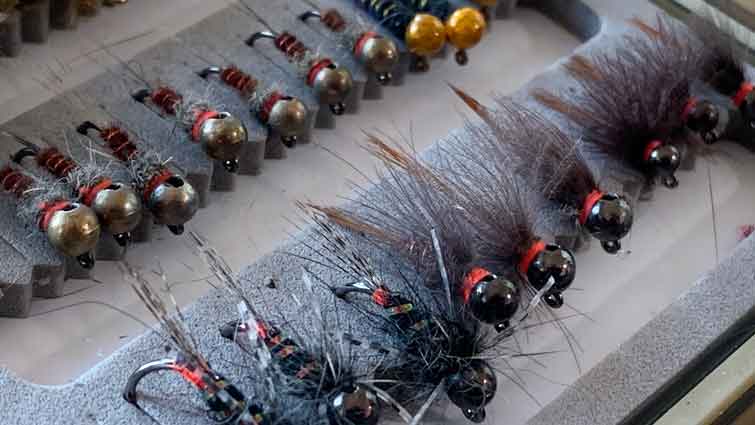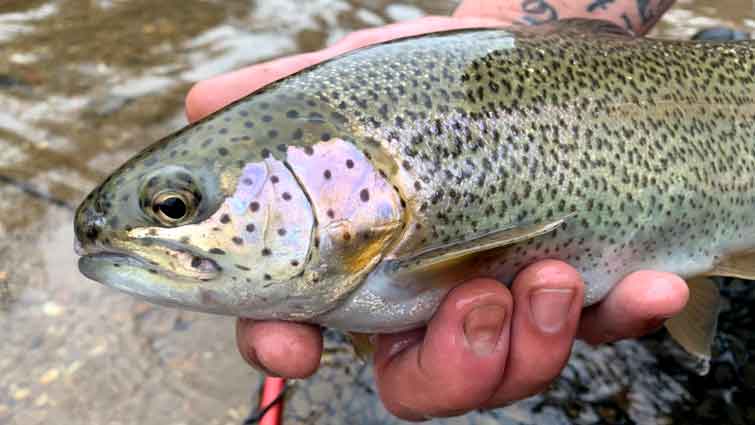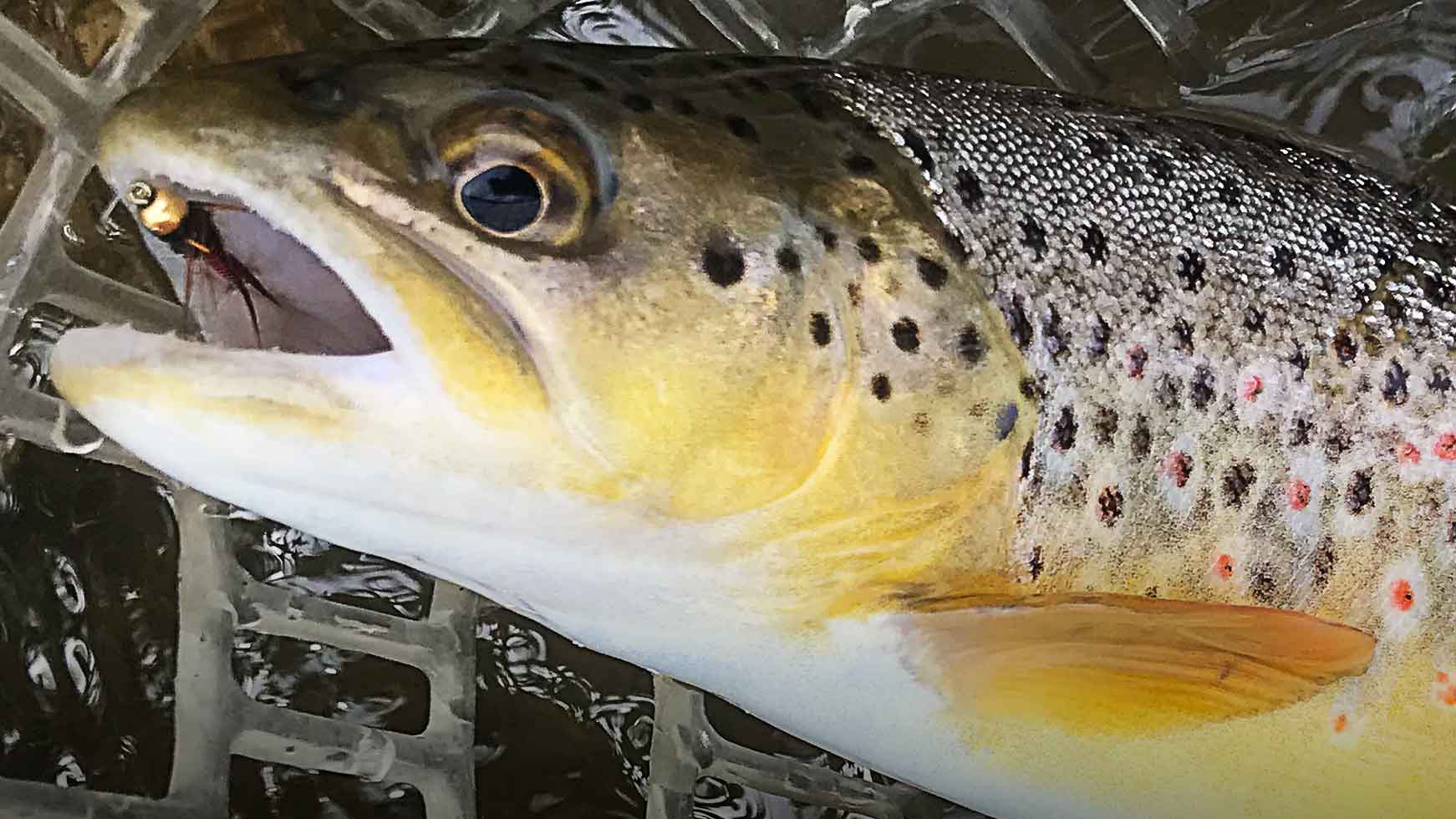European nymphing is different from traditional nymphing in that the flies are weighted rather than using a natural presentation. The flies are generally smaller and tend to use more weight than other forms of nymph fishing.
The most popular sizes for Euro Nymphing are 14 and 16. Some frequently fish Euro nymphs up to size 6 on large rivers. Nymphs as small as 18-22 are also fished solo or tangent with larger point flies. On average most Euro Nymphing Flies are bead-headed, ranging from 1.5mm (1/16) to 4.6mm (3/16) depending on hook size and pattern type. A good Euro Nymph Assortment will have multiple wights/sizes for each pattern to maximize the time your fly spends in the feeding zone.

As they are known among fly fishers, Euros can be fished anywhere and is typically fished on an extended leader setup. The fly size on your rig will vary depending upon the water type your trying to Euro Nymph. Typically heavier point flies are used when fishing faster water.
Euro Nymph Flies for Trout Fly Fishing in the U.S.
At the heart of Euro Nymphing is getting your line down deep where trout are holding so you can present them with their preferred meal, which for much (if not most) of the year are midges, mayfly or caddis patterns. To do this successfully requires a point fly that's heavy enough to carry your flies down into feeding depths in the run that you are fly fishing.
Nymphs larger than 16 are possible on little streams where you can cover lots of water with your cast and drift without spooking any fish along the way. A heavily weighted fly, often tied on a jig hook, is referred to as a Euro Nymph. These flies are generally made with tungsten beads or lead wire, giving them extra weight. This eliminates the need for a split shot and makes it possible to have a clean connection from your rod tip to the flies.
Identifying Euro Nymphing Flies
You'll need to identify the aquatic insects in your area that are most likely found on the river bottom. Matching the hatch is not necessarily the goal when you're nymphing because trout are often eating small crawfish, minnows, and other prey.

Fast Sink Rate
Euro nymph flies have an advantage over split shots and other traditional forms of weight because they sink at a much faster rate. This gives your flies more time to work the bottom, where trout often feed during low light conditions such as pre-dawn.
Nymphing is effective throughout the season, but it really shines when fishing pressure increases and fish begin to relate to patterns better than traditional dry flies.

Slim Profile
Euro nymph flies are tied very slim, allowing them to drift along the river's bottom naturally. Many of these patterns are tied weightless or with low amounts of lead wire, so they can be fished close to cover without spooking fish.

Trigger Point
For euro nymph flies, you'll need to tie them on a long shank hook with the bend of the hook pointing towards the tip of your fly. This gives you more room to work with when rigging up and enables you to use much longer droppers than you would with traditional nymphing flies that are often tied on standard or scud bug hooks.

Jig Hook
Jig hooks are ideal for euro nymphs because the slightly upturned bend will not crimp your leader material when you set the hook. Larger sizes such as a 2 or 4 can be fished in slower water, while smaller sizes like a 16 and 18 are best suited for faster water where fish feed on tiny prey.

Matching the Hatch: Euro Nymphing Flies for Caddis, Stoneflies, Mayflies and Midges
Caddis, Stoneflies and mayfly patterns make up much of what's called Euro Nymphing today. Matching caddis colors to your local river bottom is essential, but it's equally important that you match the size and color of emerging mayflies in your area. Emerging insects such as blue-winged olives and large Pale Morning Duns are a favorite food source for trout in spring and early summer.

Stonelfy patterns such as the Copper John can be fished with a euro nymphing technique because they're slim and can cut through the water column faster.
Midge Pupa Euro Nymphs are probably one of the most effective feeder patterns because they imitate all life stages of midges found in rivers which are available all year round. Midge pupa is made with peacock herl body which had been dubbed with pheasant tail fibers on top of that. You can use wire rib or braided mono instead of tying it if they're available in your area.

During warmer months, midges are found in riffles, runs, and sometimes slow pools. When you find midges in the water, trout will be feeding on them because they're one of their favorite foods to eat after emerging from shucks. With this fly pattern, you'll be able to catch trout every season.
Midge pupa flies are often fished with a swing technique by allowing them to drift naturally through the current before moving it up or downstream. Because they are typically tied on size 16-22 hooks they dont work the best as a point fly. Try using them as your second fly to ride a little higher in the water column
Bottom Feeders: Euro Nymphing Flies for Scuds, Leeches, and Minnows
Euro nymphing flies tied to look like scuds, leeches and worms work well, too, because these insects make up a large part of a trout's diet year-round.
Sluggish currents along the bottom of rivers and lakes produce plenty of food for fish, and there's no reason not to target them with a fly that can be fished vertically with a jig motion. Anglers often use homemade patterns tied from deer hair or rabbit strip material to mimic leaches or worms in such situations.

These materials can be cut down to mimic smaller scuds and leeches without looking too bulky on the hook. Similarly, micro leeches can be fished effectively on sized 12 or 14 for fast water conditions where trout are feeding.
What Size Streamer Flies for Euro Nymphing?
Streamers such as the Muddler Minnow and Woolly Bugger can be effective on euro nymphing flies because they resemble baitfish, crayfish, and leeches which trout feed on all year round. These large streamers sit high in the water, so anglers must cast them upstream and across and allow them to drift naturally.
Keep a tight line on your rig while dead drifting and retrieving as you would in a typically streamer retrieve.
The most common sizes for Euro Nymphing are 14 and 16. Some fishermen may fish nymphs as big as six on major rivers or anticipate a significant fish strike. Small streams can support diminutive nymphs as small as 22. The influence of the environment and aquatic lifecycle on your decision will become evident in the long run.
What Is the Best Size Fly for Trout?
When it comes to the color and size of the fly to use, there is no hard and fast rule for trout. Therefore utilize patterns with many hues so you may replicate all of the various life stages in their diet, and sizes between 12-22 will cover most conditions.
Brown trout prefer wet flies, streamers, and dry flies. Dry fly sizes 12-16 are perfect for brown trout; wet fly sizes 12-18 are also effective. We recommend matching the hatch and using smaller flies as small as size 22 for more pressured trout, particularly in tailwaters.

How Do I Decide What Fly To Use?
Flies are one of the most important and valuable equipments for any fly fisherman. There are thousands to select from, and choosing those that suit you might be difficult. Flies come in various forms, sizes, and colors; some make noise while others stand out more. It's critical to know which type of flies to use while trout fishing various bodies of water.
Some of the best flies to use will imitate different species like:
- Midges
- Mayflies
- Caddis
- Stoneflies
When choosing a fly for trout, matching the hatch is always essential, so bring along a variety of nymphs that match up with what may be hatching at any given time during your day on the river or lake.

It is going to depend on the size of the stream and trout you are fishing. For a general rule, it's best to use small flies when fishing clear water and larger patterns in murkier conditions. Try using earth tones like browns, greens, grays, blacks for brown trout fishing from a boat or bank.
What Is the Difference Between Nymphing and Euro Nymphing?
The main difference between European Nymphing and traditional setups is simple. There are minor changes that make the system more efficient in getting the flies in the correct zone quicker.
There is no indicator (suspension device) that floats on the surface with European Nymphing. Your indicator is incorporated into the leader itself (sighter).
This serves two purposes. First, it provides a visual clue by deviating or pausing during the drift. Secondly, this in-line system will tell you what the flies are doing below the surface since the indicator/sighter will always point to where the flies are. For example, you make a cast and hit a faster current sweeping away from your position in the stream, the indicator/sighter will point at the opposite bank, and the flies will sweep high in the water column instead of sinking.

Euro Nymphing is a unique and popular form of fishing. Although we’ve covered the basics, there are many nuances that you should consider before jumping into this style of nymphing. You may need to do some research on your own or consult with an expert for more information about using Euro Nymphing in different environments. The most important thing when it comes to catching fish is knowing what size fly will work best for the situation at hand- be prepared!
Choosing the right size fly will depend on how big the river or stream is you're fishing in. Some popular sizes include 14 and 16, but there have been reports of using incredibly small flies such as 16 on little streams! Environmental conditions and aquatic life cycles will ultimately play a role in what type of fly you decide to use, so keep these things in mind when choosing which one works.





